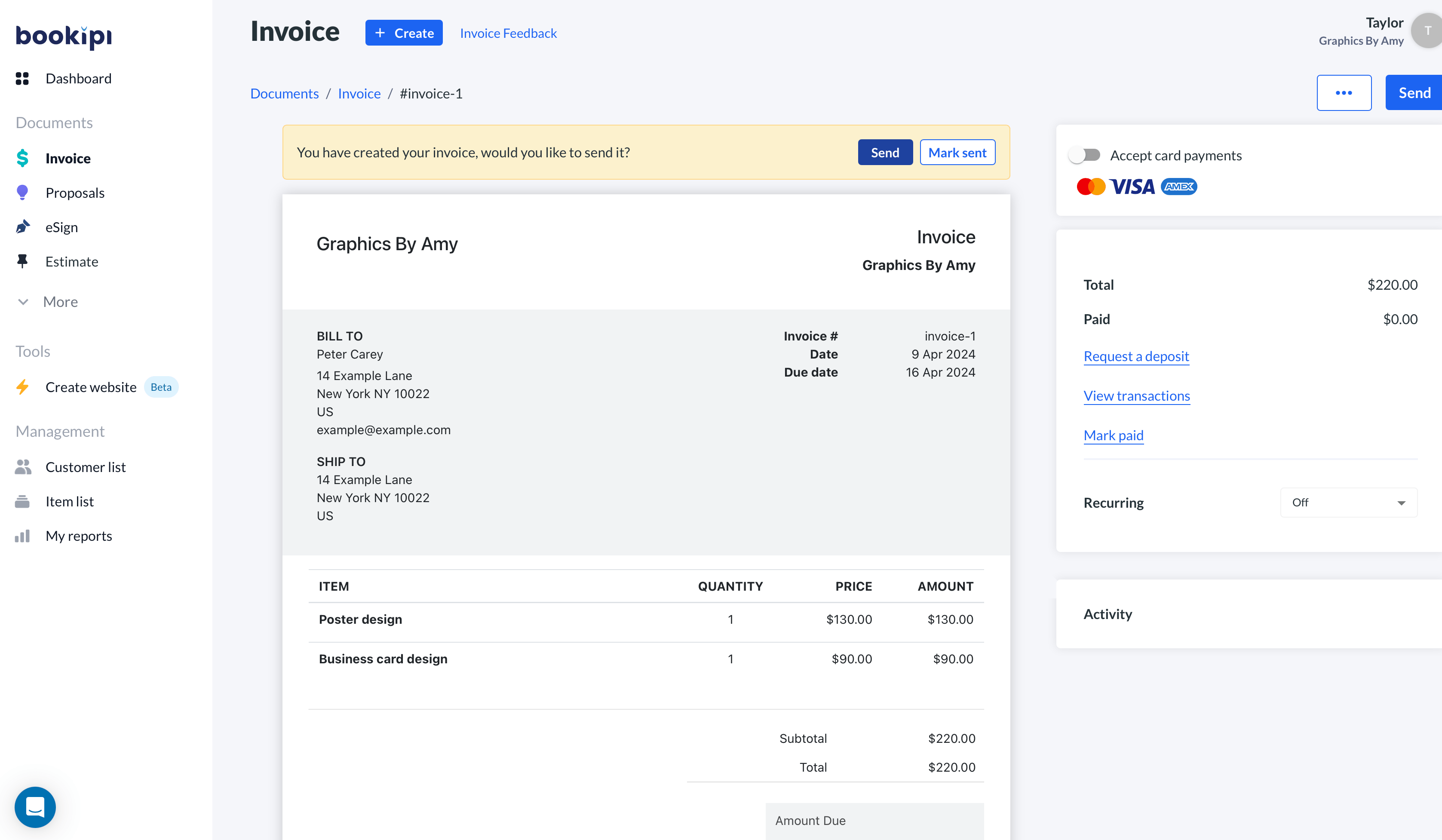Pricing your products and/or services is difficult.
If your prices are too high, you risk being seen as too expensive and your business won’t be competitive.
If your prices are too low, you risk undervaluing yourself and you might struggle to make a profit.
You want to find the perfect balance between maximising profits and maintaining a good relationship with your clients.
Effective pricing is necessary for small businesses to avoid any serious financial problems and let them run their businesses for a long time.
We’ve put together this plan to help you effectively price your products and/or services. In this plan, you will learn about calculating costs, coming up with business objectives, building a pricing strategy, researching the market, discounts and adjusting pricing.
While you go through this plan, remember:
-
- You are in business to make a profit.
- It is easier to lower prices than it is to raise
- Research will prevent you from making mistakes
Calculate the costs of running your business
The cost of your products and/or services is the amount that you will spend to produce them. To make a profit, you need your prices to be greater than the costs.
Before you set your prices, calculate how much it will cost you to deliver the products.
This doesn’t just include manufacturing and labour costs. You also need to factor in taxes and the additional costs of running your business that might not be directly related to the project.
Some costs to remember are:
-
- Manufacturing costs
- Equipment
- Pieces and parts
- Labour hire
- Travel costs
- Tax
- Other business costs, i.e. insurance, software, rent, etc.
It’s also a good idea to set aside some extra money for unexpected costs that might pop up during the project. To understand your small business cash flow, it’s important to track expenses using simple tools for small business.
Think about your objectives & the state of your business right now
How you price your products and/or services depends on what your business goals are.
You might already have some clearly defined goals but if not, take a moment to assess your business.
Ask yourself:
-
- How long have you been running your business?
- What are your competitors like?
- Is the current market crowded?
- What makes your business stand out?
- What do you want to be known for?
All of these things can impact the goals you set for yourself.
For instance, if you are a new business, you might be more focused on securing clients than making a profit.
Or, if you’re a well-established business, you might want to be known for providing a high quality service so you can charge more for your services.
Once you have a clear understanding of your business’ current position, define your objectives and goals.
These could be:
-
- Achieving a profit goal
- Offering the most competitive price
- Building a client base
- Establishing yourself as a luxury service
With these goals in mind, you are better set to pick a pricing strategy.
Come up with a pricing strategy
With your objectives in mind, you can pick a pricing strategy or combine a few pricing strategies.
There are a range of strategies to pick from, including:
- Cost-based strategies
- Competition-based strategies
- Value-based strategies and;
- Product based pricing strategies.
Cost based pricing strategies
Cost-plus pricing
With cost-plus pricing, you need to calculate the costs of producing and distributing your products and/or services. Then, you add a margin on top.
If you choose cost-plus pricing, remember to factor in all costs like tax, general costs of running a business. It’s also important to include a buffer as a safety net should you underestimate the costs of the job.
Charge per hour
With hourly charge rates, you price yourself at an hourly rate that covers the costs of running your business.
Typically, this strategy is used by service-based businesses, freelancers and contractors.
Once again, you must ensure that the hourly rate you charge is enough to cover all the costs as well as the time and work you will do outside of business hours.
Competition-based pricing strategies
Going rate pricing
With going rate pricing, you take the price of the market leader and adjust it depending on the exact products and/or services that you offer.
An advantage of this strategy is that the market leader has likely already adjusted their pricing to cover the costs of running their business and optimised it for profit.
The biggest disadvantage of this strategy is that it assumes that your business operates similarly to your competitors.
Value-based pricing strategies
Value pricing
With a value pricing strategy, you set a price for your products and/or services based on what your customers think your products and/or services are worth.
You need to conduct market research and testing to determine the value of your products and/or services.
You can then set your price or adjust your products and/or services so they are more valuable and worthy of a higher price.
For instance, if your products and/or services saves a lot of time and money for your customers, they are more likely to pay more for them.
One disadvantage of this strategy is that your customers might undervalue what you offer. It might not be enough to cover your business costs.
Premium pricing
Premium pricing can be set when you offer an exceptionally high quality product and/or service.
Your customers will have high expectations of your business and expect a luxury or elite experience with your business.
Product-based pricing strategies
Penetration pricing
With a penetration pricing strategy, you set a low initial price so you can gain market share and acquire clients. Once you have reached your target number of clients or market share, you raise your prices to normal rates.
A disadvantage of this strategy is that you may end up undervaluing your products and/or services.
It can be hard to make people see your business’ value once you raise your prices.
Skimming pricing
With skimming pricing, you set a high initial price to excite audiences that typically buy high-end, exclusive products.
Once you’ve made adequate profit from this market, prices are lowered so you can reach a wider audience.
Loss leader pricing
With loss leader pricing, you attract customers by offering your products and/or services for less than your costs.To break even, you try to upsell other products and/or services that you offer that they might be interested in.
Do your research
Market research is necessary for you to find the best price for your business.
However, initial research isn’t enough. The research process is ongoing and you should be constantly measuring and adapting your pricing as the market changes.
We cover elements of market research below:
Market testing
Market testing helps you find out how much your customers want to pay for your products and/or services.
Find out what criteria is important for them when they engage with businesses like yours.
Look at:
-
- The demand for your products and/or services
- The standard pricing for products and/or services like yours
- The quantity that they will purchase
- Any add-ons they might be interested in
Use a range of resources for your market testing, including online research and customer interviews.
From your market testing, you will be able to find out what is an acceptable price range for you to charge.
Competitors
Knowing who your competitors and what sets your business apart from them impacts how you price your products.
Your competitor pricing should not be the sole thing you use because you don’t want to undervalue your business when customers might be willing to pay more for your products and/or services.
However, competitor research is a helpful way of supporting your other research and can help you adjust your pricing as needed.
Price sensitivity
Price sensitivity refers to how prices fluctuate as customer demand changes.
Some goods and services have high price sensitivity and even a few cents can impact a customer’s behaviour and cause them to look elsewhere.
Price sensitivity changes over time based on the economic situation, competition and demand.
Level of demand
Depending on the demand for your products and/or services, you can charge more or less for your offerings.
High demand usually means that you can raise your price.
However, price can also influence demand and you might find that setting low prices increases demand for your products and/or services.
Level of competition
How much competition there is amongst businesses like yours also impacts your pricing.
Less competition means more of a market share for your business and you have more freedom to set the rates that you want rather than what your customers demand.
However, new business can quickly change this and impact your business and the prices you set.
Government regulations
Be sure to research and factor in any government regulations, additional fees or levies that might apply to your business.
Discounts
Discounts will obviously impact how much profit you can make but they can help your business in others.
The benefits of discounting include:
-
- Attracting new clients
- Getting rid of stock
- Enticing customers to return
Depending on the impact that you want your discount to have, you can offer different types of discounts. Discount types can include the following:
-
- Special offers or pricing deals
- Packages or bundles
- Quantity discounts
- Value-added offers
- Seasonal or periodic discounts
If you want to implement a discount, develop a specific plan beforehand so you can better manage the discount.
Raising or lowering prices
Raising and lowering prices is unavoidable as a business owner. Before you do, ask yourself:
-
- What effect will this have on the volume of sales?
- What will the effect be on the profit of sales?
If you increase your price, you may drive your profits up even if your sales volume drops.
When you explain the price increase to your customers, re-emphasise all the benefits they get from doing business with you.
If you reduce your price, you risk undervaluing your products and/or services but it may be necessary as the market changes to help your business remain competitive.



